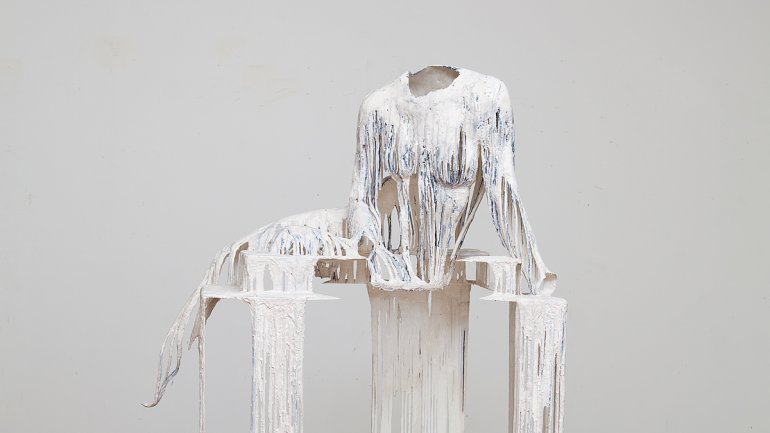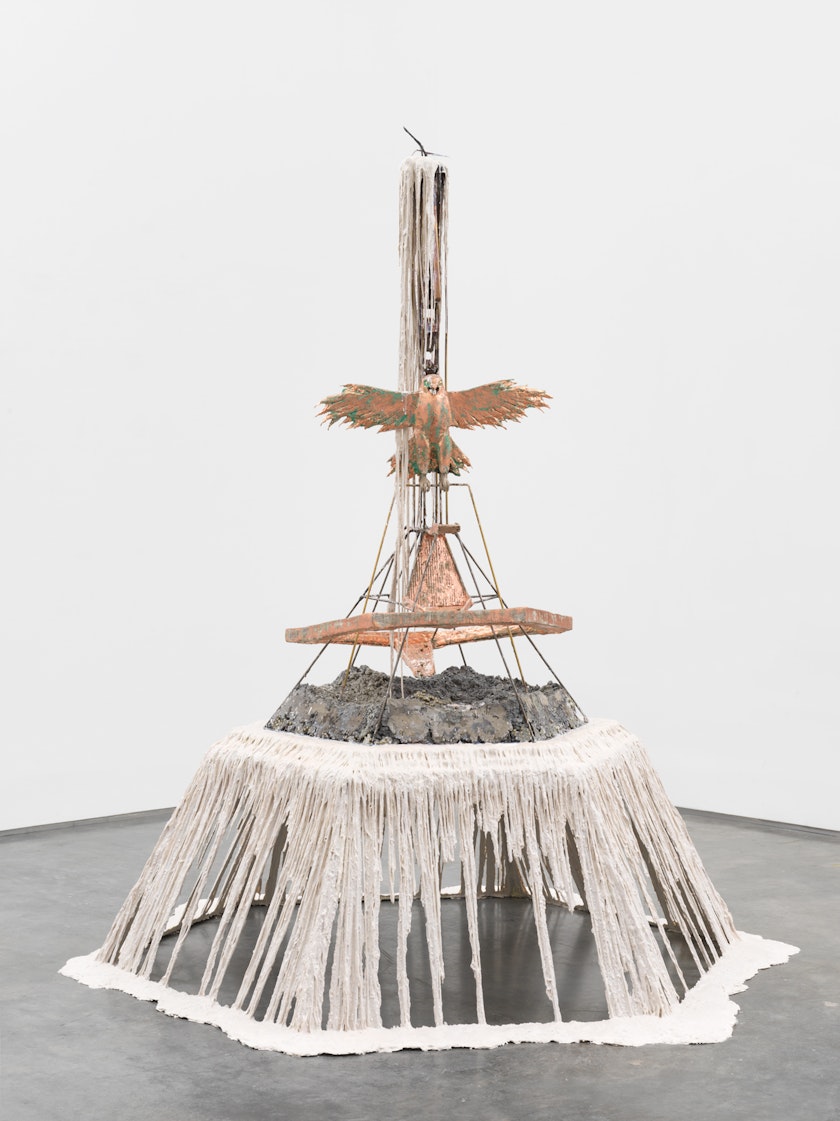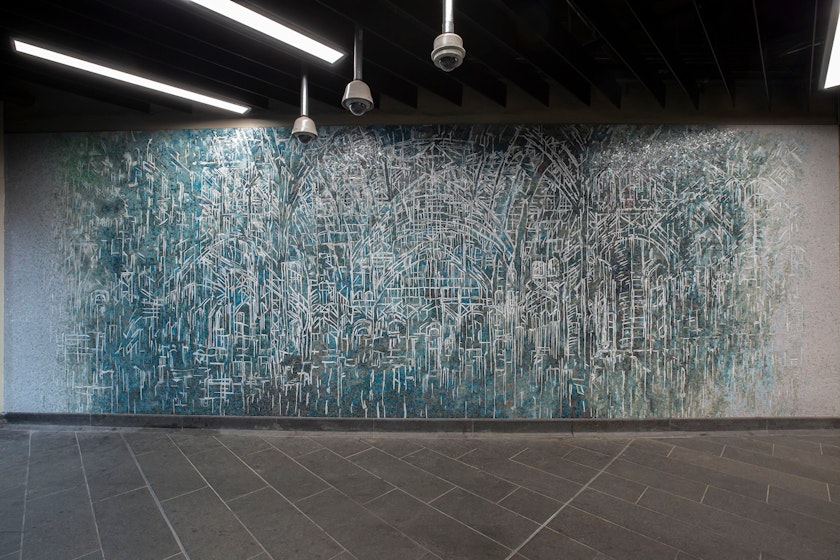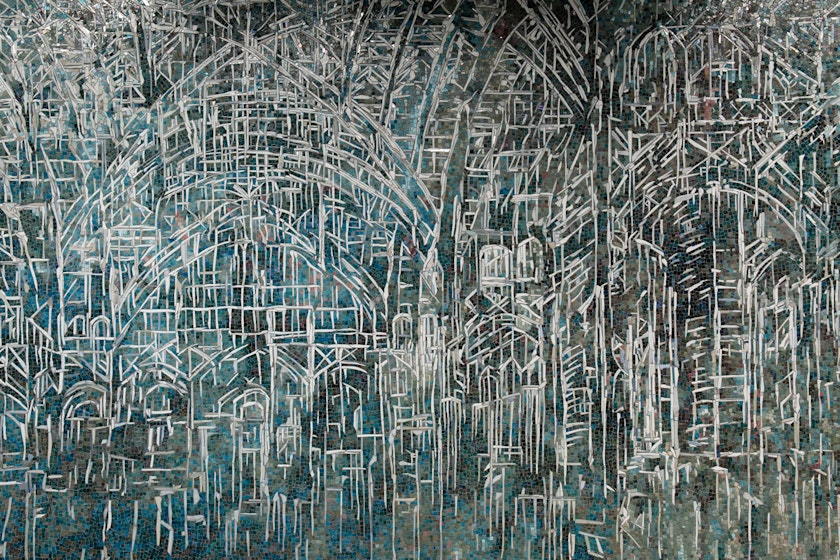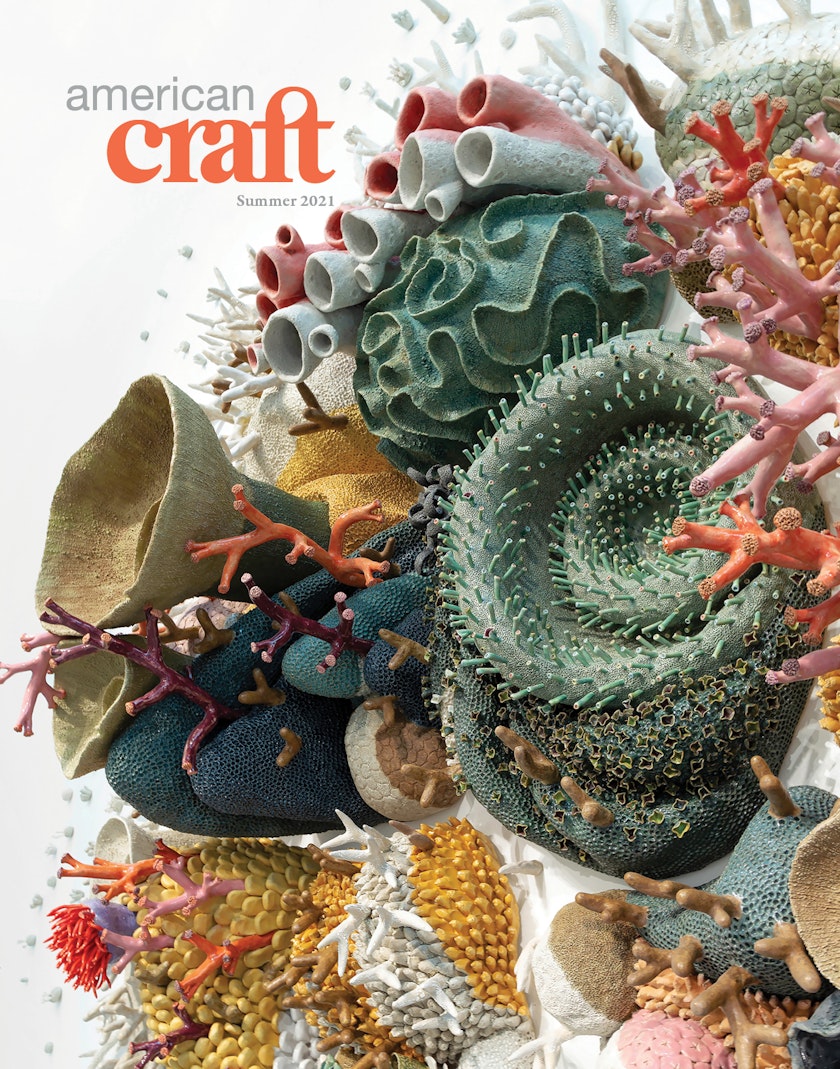Absence Made Present
Absence Made Present
For Zeyn Joukhadar, Synonym (2015) recalls a ghostly figure hovering above “its own pooled outline,” which Al-Hadid created from white polymer gypsum. Photo by Isabel Asha Penzlien.
In Al-Hadid’s work, what one might be tempted to call negative space is rarely emptiness. Some of her pieces reveal only the edges of a figure, the space a body might have once occupied, as though her subject has vanished from beneath a layer of polymer. Just as often, though, what one might interpret as memory can also be its opposite; by glimpsing the edges of a missing shape, we are made to see the figure that could reside within them. In Al-Hadid’s hands, paint dripped over what is unseen or what is past is also space left open for the infinite potential of what it might one day contain, a vacuum of possibility that pulls all things toward it, like a singularity.
As a writer, I first understood the power of negative space from the protagonist of my second novel, The Thirty Names of Night. The blocked Syrian American transgender artist at the center of the book is still choosing a new name when we meet him. As he searches for the language to describe himself, eventually calling himself Nadir, he unravels the mystery of the rare bird his ornithologist mother and a mysterious bird artist both saw before their deaths. In his search, he discovers the lives and hidden histories of queer and trans people in his own community, including other artists with their own hungers. It is in uncovering these shared cultural and artistic histories—not at all absent, but palpably present—that Nadir is able to imagine a future for himself. It is the pull of all that survives unseen around him that allows him to envision what might come after it.
In our creative practices as artists, we often engage with archives—a term I was first introduced to in this sense by writer Alexander Chee—that include not only source material directly related to our projects, but also our own personal histories, culture, data, even obsessions. We are in constant dialogue with the cultural and historical forces that have shaped us. In this sense, Al-Hadid’s own archive is vast, encompassing influences and inspirations as diverse as Islamic miniaturists, the delicate details of the Flemish Primitives, the history of the Middle Ages, the early Renaissance, and surrealism.
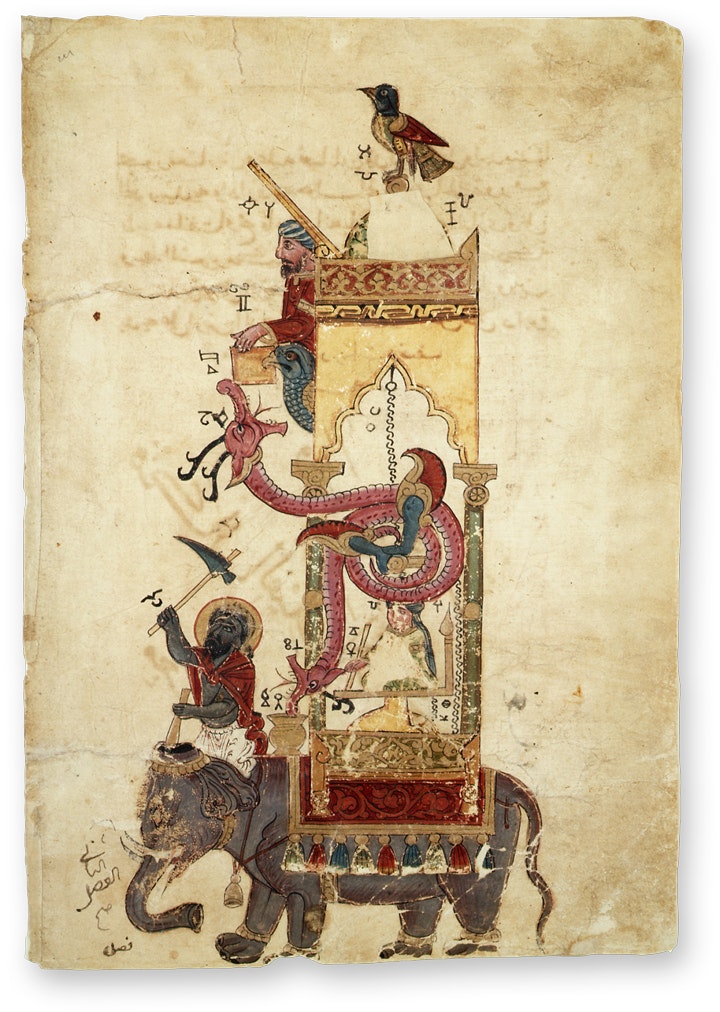
This illustration of Ismail al-Jazari’s Elephant Clock appeared in The Book of Knowledge of Ingenious Mechanical Devices. Photo courtesy of The Metropolitan Museum of Art, bequest of Cora Timken Burnett, 1956.
The Islamic Golden Age has provided Al-Hadid with rich material for her sculptural candle clocks, for example, which were partially inspired by the work of the medieval Muslim polymath, inventor, and Artuqid court engineer Ismail al-Jazari, who designed his own candle clocks and in 1206 detailed them in The Book of Knowledge of Ingenious Mechanical Devices. In these clocks—often elaborately decorated with peacocks, elephants, even dragons—a burning candle triggers a system of pulleys, weights, and rods that activate the clock and mark the passage of time. A ball released might pass a set of tick marks, say, and fall through the beak of a falcon, or a swordsman’s blade might clip the candle’s wick. Al-Jazari’s inventions are part of a long tradition of clock making in Anatolia and the Levant that extends back to ancient Mesopotamia, Egypt, Greece, and beyond, and his brilliant designs are still marveled at to this day. A replica of one of al-Jazari’s water clocks, the Elephant Clock, resides in Dubai; his astronomical Castle Clock was so complex it has been referred to by some as the first analog computer.
In The Candle Clock of the Swordsman, Al-Hadid does not replicate al-Jazari’s designs, but builds on and reimagines them. Cascading drips of white polymer gypsum in the sculpture’s bottom tier evoke candle wax, and the centerpiece, a gold and green falcon with wings outstretched, nods to al-Jazari’s fondness for decorative animals. Originally, Al-Hadid timed the work to coincide with a total solar eclipse so that, in another nod to al-Jazari, the burning of a candle would cause the gradual release of a series of small balls.
The Islamic Golden Age has provided Al-Hadid with rich material for her sculptural candle clocks…which were partially inspired by the work of the medieval Muslim polymath, inventor, and Artuqid court engineer Ismail al-Jazari.
What I love about much of Al-Hadid’s work, including her candle clocks, is that her takes on al-Jazari’s designs make the rich potentiality of history present to the viewer. The possibilities contained by the past are transformed into tangible objects, so that al-Jazari’s inventions are not static things to replicate but ideas that can be adapted, improved upon, and conversed with. In Al-Hadid’s work, history and memory are in constant movement.
Another example of this transformation can be found in her permanent mosaics in New York’s Penn Station, installed in the mezzanine spaces to commemorate the now-demolished old station. In two long murals, Al-Hadid transforms the outlines of the old station’s grand arches and silhouetted figures into interiorities spacious enough to flee into. The gray-green shadows and white streaks of angles give the mosaics an ever-shifting, dynamic quality. The hum of that disappeared station lies behind the glass tile, alive. Not destroyed, only momentarily out of reach.
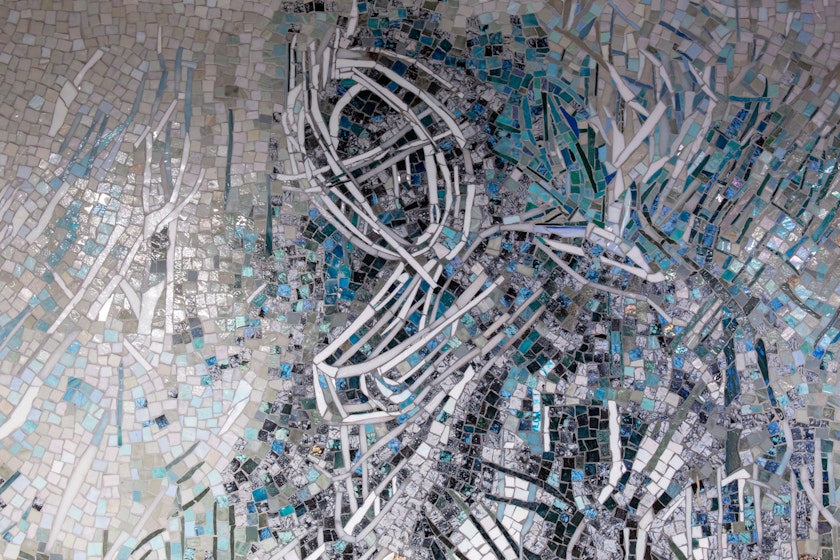
Al-Hadid's two permanent mosaics in New York’s Penn Station feature arches of the old station and human figures with white streaks and gray-green shadows. Photos by Peter Kaiser.
Perhaps every work is sparked this way: the artist sees not the raw materials around them, but the thing that rawness hides, waiting to be born. Smoke and Mirrors originally began as a pedestal, Al-Hadid tells me. In the final piece, this pedestal remains only as the suggestion of an icy tabletop suspended above a mesh of roots. Their rigidity suggests petrified wood, but the black and violet surge of them, atop which the white platform is poised, suggests a billow of hot, dark smoke. Above this arch of roots rises a puffed cluster of creamy material, like the smooth honeycomb inside a broken conch, supporting a golden head. Beneath all this the pedestal has been transformed, tugged upward into the white trunk of an eager tree, its base yawning open like excavated earth.

Smoke and Mirrors (2015) is made from polymer gypsum, fiberglass, steel, wood, concrete, polystyrene, black mesh, and pigment. Photo by Joshua White.
Looking at Smoke and Mirrors, I am struck by the sense of all that dwells within the materials from which we begin, the sense of an interior space that is made accessible only by the process of the work itself. This interior space of possibility, in Al-Hadid’s hands, becomes a place of refuge.
In Night Inside, polymer gypsum is draped like shorn silk over an architectural structure visible only in the mind’s eye: the vaulted two-dimensional hall seems to inhale, to move away from the viewer; it becomes an opened door, the back of a throat. Observing Synonym, the viewer is privy to the space once occupied by a body. What lies within that space is rendered visible through the controlled drip of white polymer gypsum shot through with blue, so that the ghostly figure hovers above its own pooled outline. Self Delusions evokes this same suspension, mirrored: a second body is set below the first, the upper figure dripped in waxy white and the lower one edged in gold leaf, its thigh cross-sectioned. At just the right viewpoint, the two partial figures merge into one, but the combination is jarring. They connect according to their own logic, overlapping and then separating. The polymer gypsum coats the space where these bodies might once have been, as though they were raptured from within a rind of wax while still in motion. One might mistake the interior hollow of these figures for negative space, but their emptiness is vibrant and charged. In making their missingness visible, these bodies feel not absent, but eerily and unmistakably present, as though they might, at any moment, return.
Perhaps every work is sparked this way: the artist sees not the raw materials around them, but the thing that rawness hides, waiting to be born.
As a Syrian American writer, to view the work of a Syrian American artist is perhaps to be able to read the work, at least in part, through the lens of a shared archive. It is a pleasure to read shared history, shared curiosity—at times, possibly, shared grief. But what I am most struck by in Diana Al-Hadid’s work is her fierce commitment to her process, the way her inquisitiveness about her influences and her materials guides her making. Perhaps the most moving thing about her work, for me, is not any sense of missingness or of absence, but rather the opposite, the rich presence and possibility of all that her work invokes. In Thirty Names, the thing that eventually allows Nadir to move beyond his artist’s block is the knowledge of the creative legacies of his ancestors and community elders that are present all around him. In Al-Hadid’s work, too, the unseen and the remembered are anything but absent. In her work, the viewer is invited to be awake to the presence of the past and to the limitlessness of interiority; to the echoes of a vanished train station; to the canvas of a pedestal transformed by the sculpture born from within it, like a peat flowerpot blossomed open by a sapling’s root.
dianaalhadid.com | @dianaalhadid
Discover More Inspiring Artists in Our Magazine
Become a member to get a subscription to American Craft magazine and experience the work of artists who are defining the craft movement today.


